一、二叉树入门
1.1 数的基本定义
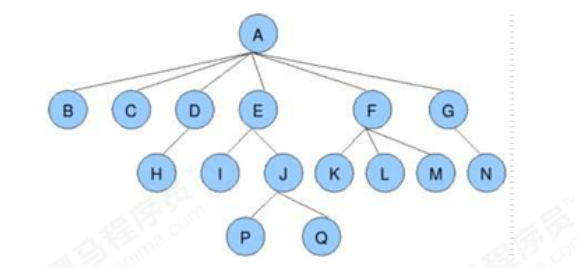
树具有以下特点:
- 每个结点有零个或多个子结点;
- 没有父结点的结点为根结点;
- 每一个非根结点只有一个父结点;
- 每个结点及其后代结点整体上可以看做是一棵树,称为当前结点的父结点的一个子树;
1.2树的相关术语
结点的度:
一个结点含有的子树的个数称为该结点的度;
叶结点:
度为0的结点称为叶结点,也可以叫做终端结点
分支结点:
度不为0的结点称为分支结点,也可以叫做非终端结点
结点的层次:
从根结点开始,根结点的层次为1,根的直接后继层次为2,以此类推
结点的层序编号:北京市昌平区建材城西路金燕龙办公楼一层 电话:400-618-9090
将树中的结点,按照从上层到下层,同层从左到右的次序排成一个线性序列,把他们编成连续的自然数。
树的度:
树中所有结点的度的最大值
树的高度(深度):
树中结点的最大层次
森林:
m
(m>=0)个互不相交的树的集合,将一颗非空树的根结点删去,树就变成一个森林;给森林增加一个统一的根
结点,森林就变成一棵树
孩子结点:
一个结点的直接后继结点称为该结点的孩子结点
双亲结点(父结点):
一个结点的直接前驱称为该结点的双亲结点
兄弟结点:
同一双亲结点的孩子结点间互称兄弟结点1.3二叉树的基本定义(二叉树就是度不超过2的树(每个结点最多有两个子结点))
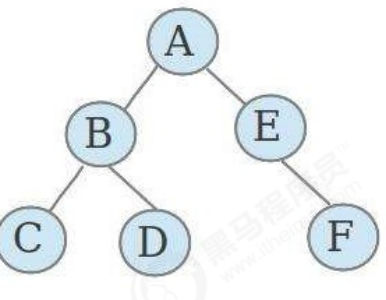
满二叉树:
一个二叉树,如果每一个层的结点树都达到最大值,则这个二叉树就是满二叉树。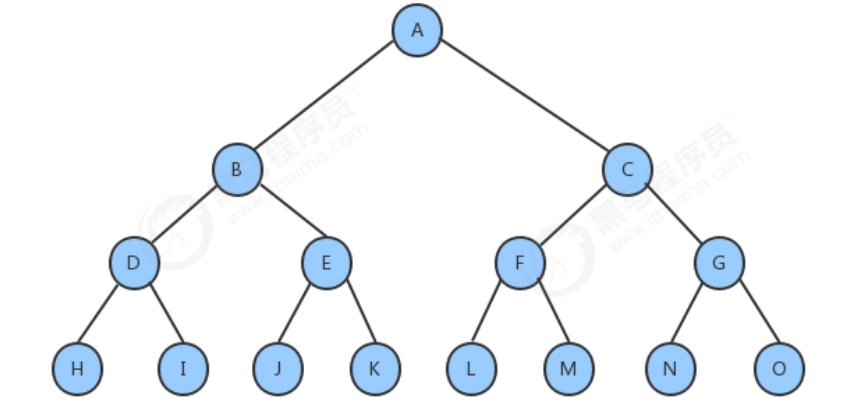
完全二叉树:
叶节点只能出现在最下层和次下层**,并且最下面一层的结点都集中在该层最左边的若干位置的二叉树

1.4 二叉查找树的创建
1.4.1二叉树的结点类
二叉树其实就是由一个一个的结点及其之间的关系组成的,按照面向对象的思想,我们设计一个结点类来描述结点这个事物。
结点类API设计:
| 类名 | Node |
|---|---|
| 构造方法 | Node(Key key, Value value, Node left, Node right):创建Node对象 |
| 成员变量 | 1.public Node left:记录左子结点 2.public Node right:记录右子结点 3.public Key key:存储键 4.public Value value:存储值 |
1.4.2 二叉查找树API设计
| 类名 | BinaryTree |
|---|---|
| 构造方法 | BinaryTree():创建BinaryTree对象 |
| 成员变量 | 1.private Node root:记录根结点 2.private int N:记录树中元素的个数 |
| 成员方法 | 1. public void put(Key key,Value value):向树中插入一个键值对 2.private Node put(Node x, Key key, Value val):给指定树x上,添加键一个键值对,并返回添加后的新树 3.public Value get(Key key):根据key,从树中找出对应的值 4.private Value get(Node x, Key key):从指定的树x中,找出key对应的值 5.public void delete(Key key):根据key,删除树中对应的键值对 6.private Node delete(Node x, Key key):删除指定树x上的键为key的键值对,并返回删除后的新树 7.public int size():获取树中元素的个数 |
插入方法put实现思想:
- 如果当前树中没有任何一个结点,则直接把新结点当做根节点使用
- 如果当前树不为空,则从根节点开始
- 如果新结点的key小于当前结点的key,则继续找当前结点的左子结点
- 如果新结点的key大于当前结点的key,则继续找当前结点的右子结点
- 如果新结点的key等于当前结点的key,则树中已经存在这样的结点,替换该结点的value值即可。

查询方法get实现思想:
从根节点开始:
1.如果要查询的key小于当前结点的key,则继续找当前结点的左子结点;
2.如果要查询的key大于当前结点的key,则继续找当前结点的右子结点;
3.如果要查询的key等于当前结点的key,则树中返回当前结点的value。
删除方法delete实现思想:
1.找到被删除结点;
2.找到被删除结点右子树中的最小结点minNode
3.删除右子树中的最小结点
4.让被删除结点的左子树称为最小结点minNode的左子树,让被删除结点的右子树称为最小结点minNode的右子树
5.让被删除结点的父节点指向最小结点minNode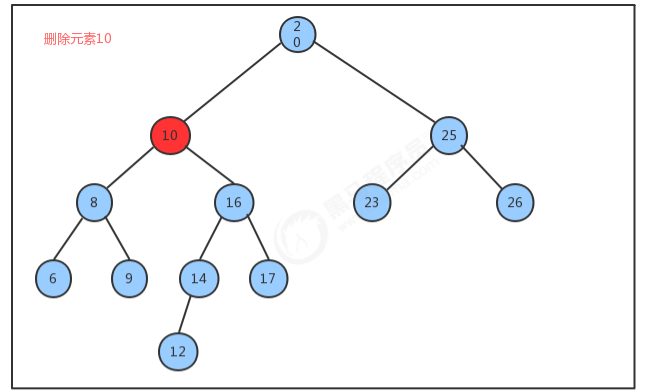
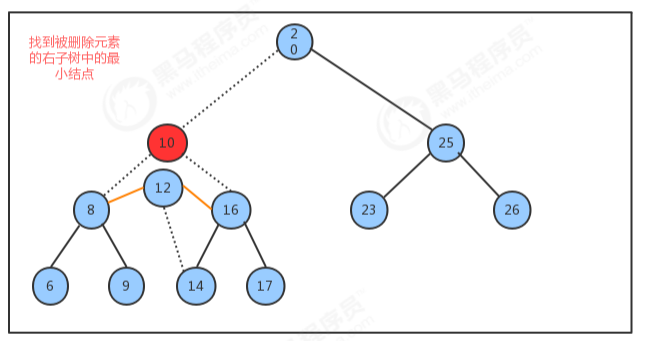
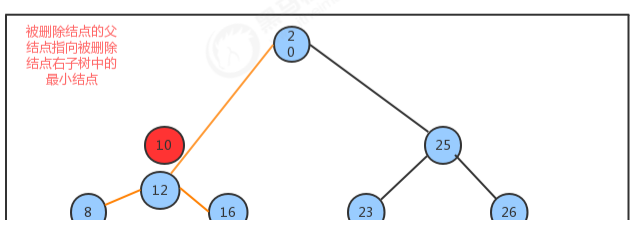
1.4.3二叉查找树创建(code):
package algorithm.tree;
public class BinaryTree<Key extends Comparable<Key>, Value>{
//记录根结点
private Node root;
//记录数中元素个数
private int N;
private class Node{
//存储键
public Key key;
private Value value;
public Node left;
public Node right;
public Node(Key key, Value value, Node left, Node right){
this.key = key;
this.value = value;
this.left = left;
this.right = right;
}
}
//获取树中元素的个数
public int size(){
return N;
}
//向树中添加元素key-value
public void put(Key key, Value value){
root = put(root, key, value);
}
//向指定的树x中添加元素key-value,并返回添加元素后新的树
public Node put(Node x, Key key, Value value){
//如果x子树为空
if(x ==null){
N++;
return new Node(key, value, null, null);
}
//如果x子树不为空
//比较x结点的键和key的大小
int cmp = key.compareTo(x.key);
if(cmp>0){
//如果key大于x结点的键,则继续找x结点的右子树
x.right = put(x.right, key, value);
}else if(cmp<0){
//如果key小于x结点的键,则继续找x结点的左子树
x.left = put(x.left, key, value);
}else{
//如果key等于x结点的键,则替换x结点的值为value即可
x.value = value;
}
return x;
}
//查询树中指定key对应的value
public Value get(Key key){
return get(root, key);
}
//从指定的树x中,查找key对应的值
public Value get(Node x, Key key){
//x树为null
if(x==null){
return null;
}
//x不为null
//比较key和x结点的键的大小
int cmp = key.compareTo(x.key);
if(cmp>0){
//如果key大于x结点的键,则继续找x结点的右子树
return get(x.right, key);
}else if(cmp<0){
//如果key小于x结点的键,则继续找x结点的左子树
return get(x.left, key);
}else{
//如果key等于x结点的键,就找到了键为key的结点,只需要返回x结点的值即可
return x.value;
}
}
//删除树中key对应的value
public void delete(Key key){
root = delete(root, key);
}
//删除指定树x中的key对应的value,并返回删除后的新树
public Node delete(Node x, Key key){
//x树为null
if(x == null){
return null;
}
//x树不为null
//比较key和x结点的键的大小
int cmp = key.compareTo(x.key);
if(cmp>0){
//如果key大于x结点的键,则继续找x结点的右子树
x.right = delete(x.right, key);
}else if(cmp<0){
//如果key小于x结点的键,则继续找x结点的左子树
x.left = delete(x.left, key);
}else{
//让元素减1
N--;
//如果key等于x结点的键,完成真正的删除结点的动作,要删除的结点就是x
if(x.right == null){
return x.left;
}
if(x.left == null){
return x.right;
}
//得找到右子树中最小的结点
Node minNode = x.right;
while(minNode.left!=null){
minNode = minNode.left;
}
//1.然后把右子树中最小的结点置为null,即删除右子树中最小的节点(找最小节点的上一个节点)
Node n = x.right;
while (n.left!=null){
if (n.left.left==null){
n.left = null;
}else{
n = n.left;
}
}
//2.将x.left指向右子树中最小的结点,x.right指向右子树中最小的结点
minNode.left = x.left;
minNode.right = x.right;
//3.x的父节点的左节点指向子树中最小的结点
x = minNode;
}
return x;
}
}
1.4.4二叉查找树创建测试(code):
package algorithm.test;
import algorithm.tree.BinaryTree;
public class TestBinaryTree {
public static void main(String[] args) {
//创建二叉树查找对象
BinaryTree<Integer, String> tree = new BinaryTree<>();
tree.put(1, "张三");
tree.put(2, "李四");
tree.put(3, "王五");
System.out.println("插入完毕后的元素的个数:"+tree.size());
//测试获取
System.out.println("键2对应的元素是:"+tree.get(2));
//测试删除
tree.delete(3);
System.out.println("删除完毕后的元素的个数:"+tree.size());
System.out.println("删除后键3对应的元素是:"+tree.get(3));
}
}
1.4.5 查找二叉树中最小的键和最大的键
//查找二叉树中最小的键
public Key min() {
return min(root).key;
}
private Node min(Node x) {
if (x.left != null) {
return min(x.left);
} else {
return x;
}
}
//查找二叉树中最大的键
public Key max() {
return max(root).key;
}
private Node max(Node x) {
if (x.right != null) {
return max(x.right);
} else {
return x;
}
}
1.5 二叉树的基础遍历
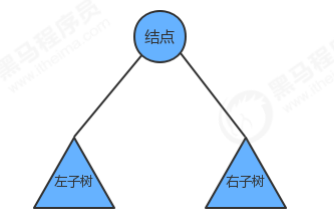
1.前序遍历;
先访问根结点,然后再访问左子树,最后访问右子树
2.中序遍历;
先访问左子树,中间访问根节点,最后访问右子树
3.后序遍历;
先访问左子树,再访问右子树,最后访问根节点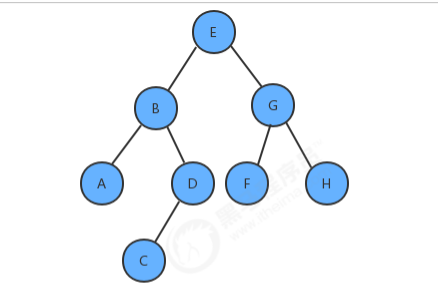
前序遍历结果:EBADCGFH
中序遍历结果:ABCDEFGH
后序遍历结果:ACDBFHGE
1.5.1前序遍历
//使用前序遍历,获取整个树中的所有键
public Queue<Key> preErgodic() {
Queue<Key> keys = new LinkedList<>();
preErgodic(root, keys);
return keys;
}
//使用前序遍历,把指定树x中所有的键放入到keys队列中
private void preErgodic(Node x, Queue<Key> keys){
if(x == null){
return;
}
//1.将当前节点的key放到队列中
keys.offer(x.key);
//2.找到当前节点的左子树,如果不为空,递归遍历左子树
preErgodic(x.left, keys);
//3.找到当前节点的右子树,如果不为空,递归遍历右子树
preErgodic(x.right, keys);
}
test:
//前序遍历
BinaryTree<String, String > tree = new BinaryTree<>();
tree.put("E", "5");
tree.put("B", "2");
tree.put("G", "7");
tree.put("A", "1");
tree.put("D", "4");
tree.put("F", "6");
tree.put("H", "8");
tree.put("C", "3");
Queue<String> keys = new LinkedList<>();
keys = tree.preErgodic();
for (String key:keys) {
String value = tree.get(key);
System.out.println(key+"----->"+value);
}
1.5.2 中序遍历
//使用中序遍历
public Queue midErgodic(){
Queue<Key> keys = new LinkedList<>();
midErgodic(root, keys);
return keys;
}
private void midErgodic(Node x, Queue keys){
if(x == null){
return;
}
//如果左子树不为空,先遍历左子树
midErgodic(x.left, keys);
//遍历根节点
keys.offer(x.key);
//如果右子树不为空,先遍历右子树
midErgodic(x.right, keys);
}
test:
//中序遍历
BinaryTree<String, String > tree = new BinaryTree<>();
tree.put("E", "5");
tree.put("B", "2");
tree.put("G", "7");
tree.put("A", "1");
tree.put("D", "4");
tree.put("F", "6");
tree.put("H", "8");
tree.put("C", "3");
Queue<String> keys = new LinkedList<>();
keys = tree.midErgodic();
for (String key:keys) {
String value = tree.get(key);
System.out.println(key+"----->"+value);
}
1.5.3 后序遍历
//使用后序遍历
public Queue afterErgodic(){
Queue<Key> keys = new LinkedList<>();
afterErgodic(root, keys);
return keys;
}
private void afterErgodic(Node x, Queue keys){
if(x == null){
return;
}
//如果左子树不为空,先遍历左子树
afterErgodic(x.left, keys);
//如果右子树不为空,先遍历右子树
afterErgodic(x.right, keys);
//遍历根节点
keys.offer(x.key);
}
test:
//后序遍历
BinaryTree<String, String > tree = new BinaryTree<>();
tree.put("E", "5");
tree.put("B", "2");
tree.put("G", "7");
tree.put("A", "1");
tree.put("D", "4");
tree.put("F", "6");
tree.put("H", "8");
tree.put("C", "3");
Queue<String> keys = new LinkedList<>();
keys = tree.afterErgodic();
for (String key:keys) {
String value = tree.get(key);
System.out.println(key+"----->"+value);
}
1.6 二叉树的层序遍历
实现步骤:
创建两个队列
一个队列keys存储键
一个队列nodes存储结点
1.创建队列nodes,存储每一层的结点;
2.使用循环从队列中弹出一个结点:
2.1获取当前结点的key放入队列keys中;
2.2如果当前结点的左子结点不为空,则把左子结点放入到队列nodes中
2.3如果当前结点的右子结点不为空,则把右子结点放入到队列nodes中
直到nodes结点为空,结束循环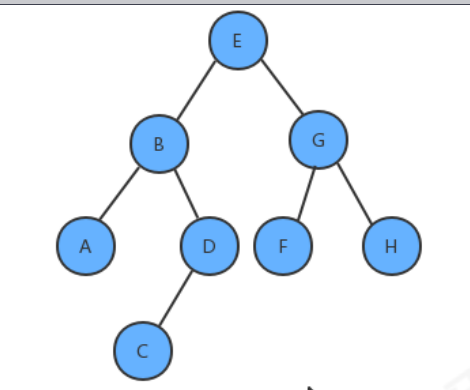
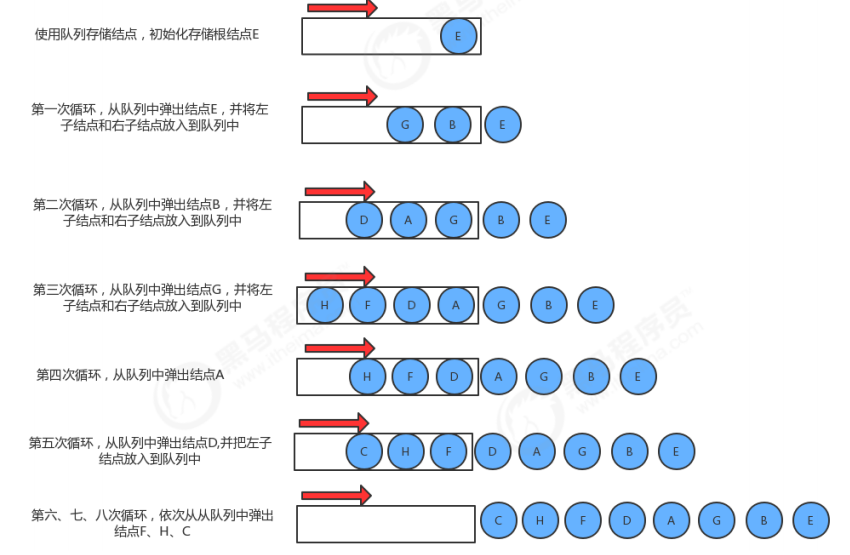
//层次遍历,获取整个树中所有的键
public Queue<Key> layerErgodic(){
//先创建两个队列,一个分别存储树中的结点和树中的键
Queue<Key> keys = new LinkedList<>();
Queue<Node> nodes = new LinkedList<>();
//默认,往队列中放入根节点
nodes.offer(root);
//当队列nodes中不为空时,做三件事
while(!nodes.isEmpty()){
//1.从队列nodes中弹出一个结点,并将key放入队列keys中
Node n = nodes.poll();
keys.offer(n.key);
//2.如果左节点不为空,放入队列nodes
if(n.left!=null){
nodes.offer(n.left);
}
//3.如果右节点不为空,放入队列nodes
if(n.right!=null){
nodes.offer(n.right);
}
}
return keys;
}
test:
//层次
BinaryTree<String, String > tree = new BinaryTree<>();
tree.put("E", "5");
tree.put("B", "2");
tree.put("G", "7");
tree.put("A", "1");
tree.put("D", "4");
tree.put("F", "6");
tree.put("H", "8");
tree.put("C", "3");
Queue<String> keys = new LinkedList<>();
keys = tree.layerErgodic();
for (String key:keys) {
String value = tree.get(key);
System.out.println(key+"----->"+value);
}
1.7 二叉树的最大深度
递归的方法:
1.如果根节点为空,则最大深度为0
2.计算左子树的最大深度
3.计算右子树的最大深度
4.当前树的最大深度=左子树最大深度和右子树最大深度中的较大者+1
//计算整个树的最大深度
public int maxDepth(){
return maxDepth(root);
}
private int maxDepth(Node x){
//如果根节点为空
if (x == null){
return 0;
}
int max = 0;
int maxL = 0;
int maxR = 0;
//2.计算左子树的最大深度
if(x.left !=null){
maxL = maxDepth(x.left);
}
//2.计算右子树的最大深度
if(x.right !=null){
maxR = maxDepth(x.right);
}
max = maxL>maxR ? maxL+1:maxR+1 ;
return max;
}
//最大深度
BinaryTree<String, String > tree = new BinaryTree<>();
tree.put("E", "5");
tree.put("B", "2");
tree.put("G", "7");
tree.put("A", "1");
tree.put("D", "4");
tree.put("F", "6");
tree.put("H", "8");
tree.put("C", "3");
int depth = 0;
depth = tree.maxDepth();
System.out.println("树的深度为"+depth);
}
1.8 折痕打印(利用树的思想)
需求:
请把一段纸条竖着放在桌子上,然后从纸条的下边向上方对折1次,压出折痕后展开。此时 折痕是凹下去的,即折
痕突起的方向指向纸条的背面。如果从纸条的下边向上方连续对折2 次,压出折痕后展开,此时有三条折痕,从上
到下依次是下折痕、下折痕和上折痕。
给定一 个输入参数N,代表纸条都从下边向上方连续对折N次,请从上到下打印所有折痕的方向 例如:N=1时,打
印: down;N=2时,打印: down down up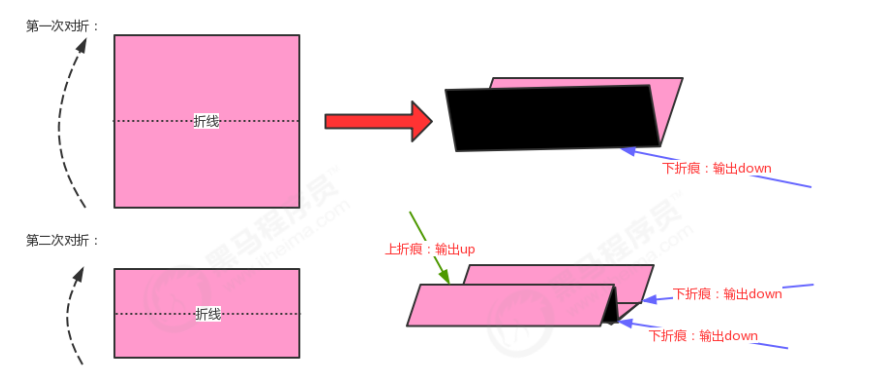
分析:
我们把对折后的纸张翻过来,让粉色朝下,这时把第一次对折产生的折痕看做是根结点,那第二次对折产生的下折
痕就是该结点的左子结点,而第二次对折产生的上折痕就是该结点的右子结点,这样我们就可以使用树型数据结构
来描述对折后产生的折痕。(倒过来形成的树的中序遍历的结果实际上就是从上到下的折痕顺序)
这棵树有这样的特点:
1.根结点为下折痕;
2.每一个结点的左子结点为下折痕;
3.每一个结点的右子结点为上折痕;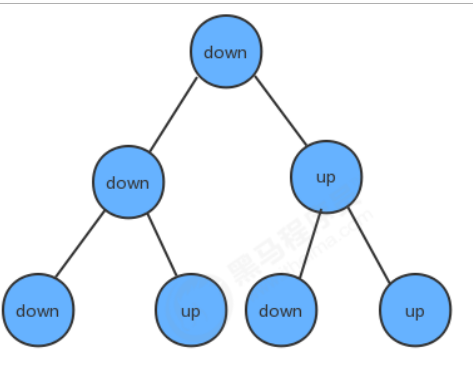
构建深度为N的折痕树:
1.第一次对折,只有一条折痕,创建根结点;
2.如果不是第一次对折,则使用队列保存根结点;
3.循环遍历队列(利用层次遍历的思想寻找到叶子节点给其添加左右子树即折痕):
3.1从队列中拿出一个结点;
3.2如果这个结点的左子结点不为空,则把这个左子结点添加到队列中;
3.3如果这个结点的右子结点不为空,则把这个右子结点添加到队列中;
3.4判断当前结点的左子结点和右子结点都不为空,如果是,则需要为当前结点创建一个值为down的左子结点,一
个值为up的右子结点。
package algorithm.tree;
import java.util.LinkedList;
import java.util.Queue;
public class PageFolding {
public static void main(String[] args) {
//构建折痕树
Node tree = createTree(2);
//遍历折痕树并打印
printTree(tree);
}
private static void printTree(Node root) {
if(root == null){
return;
}
//中序遍历
//先访问左子树
printTree(root.left);
//访问当前节点
System.out.print(root.item+" ");
//访问右子树
printTree(root.right);
}
private static Node createTree(int N) {
Node root = null;
for (int i = 0; i < N; i++) {
if(i == 0){
root = new Node("down", null, null);
}else{
//2.如果不是第一次对折,则使用队列保存根结点
Queue<Node> queue = new LinkedList<>();
queue.offer(root);
//3.村换遍历队列
while (!queue.isEmpty()){
//3.1从队列中拿出一个节点,
Node n = queue.poll();
//3.2 如果这个节点的左节点不为空,将其左子节点添加到队列中
if(n.left!=null){
queue.offer(n.left);
}
//3.3 如果这个节点的右节点不为空,将其右子节点添加到队列中
if(n.right!=null){
queue.offer(n.right);
}
//3.4如果左右节点为空,则需要为其添加左右折痕
if(n.left==null && n.right == null){
n.left = new Node("down", null, null);
n.right = new Node("up", null, null);
}
}
}
}
return root;
}
//1.定义结点类
private static class Node{
//存储结点元素
String item;
//左子节点
Node left;
//右子结点
Node right;
public Node(String item, Node left, Node right) {
this.item = item;
this.left = left;
this.right = right;
}
}
}

